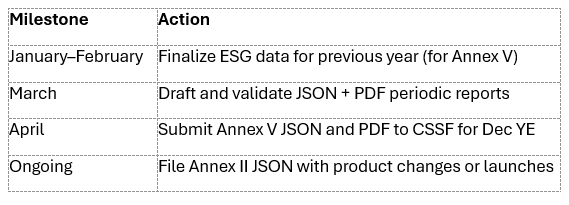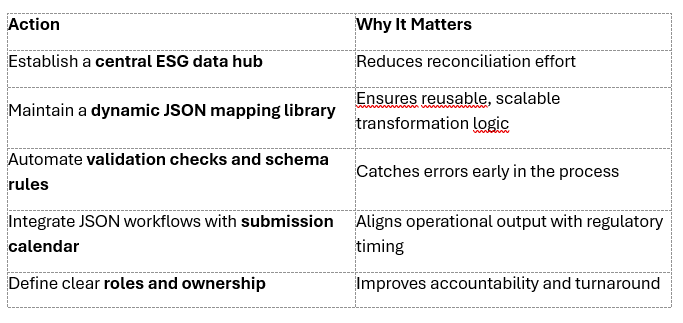
The role of the middle office in CSSF SFDR JSON reporting
As ESG regulations intensify, the role of the middle office in CSSF SFDR JSON reporting has become pivotal. This blog delves into how the middle office supports the seamless collection, validation, and transformation of ESG data into machine-readable formats, ensuring Luxembourg-domiciled funds meet compliance with precision and efficiency.
As ESG regulations become more data-intensive, the middle office is increasingly at the heart of operationalizing compliance. Nowhere is this more evident than in CSSF SFDR JSON reporting, where Luxembourg-domiciled funds must translate their sustainability disclosures into a machine-readable format — requiring precision, process integration, and robust data handling.
This article explores how the middle office supports the collection, validation, and transformation of ESG data for CSSF-compliant Annex II and Annex V JSON files, and why their role is essential to effective SFDR compliance.
Understanding the SFDR Reporting stack
The SFDR JSON submission workflow can be broken down into five stages:
- Data Collection (internal ESG systems, external vendors)
- Data Mapping & Structuring (aligning with RTS Annex templates)
- JSON Generation (automated or manual encoding)
- Validation & QA (schema and logic checks)
- Submission via CSSF eDesk (PDF + JSON)
The middle office typically drives steps 2–4, acting as the connective tissue between front-office inputs and back-office controls.
Middle office responsibilities in SFDR JSON Reporting
- ESG Data Aggregation
- Consolidating inputs from front-office ESG analysts, portfolio managers, and data vendors
- Ensuring source consistency and traceability (e.g., PAIs, taxonomy alignment, ESG scoring methodologies)
Middle office ensures that data inputs are standardized, versioned, and audit-ready.
2. Data mapping to RTS Templates
- Aligning structured ESG data with Annex II (pre-contractual) and Annex V (periodic) fields
- Maintaining a mapping document that connects internal data sources to JSON schema fields
This step is critical to enable reusability and consistency across fund types.
3. JSON file generation
- Operating or overseeing tools that transform structured templates (Excel, CSV, database) into CSSF JSON format
- Managing naming conventions, version control, and encoding (e.g., UTF-8 compliance)
Many middle office teams automate this using scripts or vendor tools to reduce manual errors.
4. Validation & pre-submission QA
- Running technical schema validation (field types, required values, logical constraints)
- Conducting cross-checks with PDF disclosures to ensure narrative alignment
- Collaborating with legal, compliance, and product teams to review final outputs
Middle office acts as the final gatekeeper before eDesk submission.
Key challenges for the middle office

How to strengthen the Middle Office SFDR process

Middle office as strategic enabler, not just executor
As SFDR evolves into a broader ESG data architecture — potentially linked to CSRD, EET, and EU Taxonomy — the middle office is becoming a strategic data steward, not just an operational conduit. Firms that empower this function with the right tools and workflows will be able to:
• Respond faster to regulatory updates
• Reduce compliance cost through automation
• Enhance ESG reporting quality across disclosures
Conclusion
The move to CSSF SFDR JSON reporting has created a critical opportunity for the middle office to drive both compliance and efficiency. By owning the data integration and validation layer, middle-office teams ensure that ESG transparency isn’t just a reporting obligation — it becomes a repeatable, scalable process that builds trust with both regulators and investors.